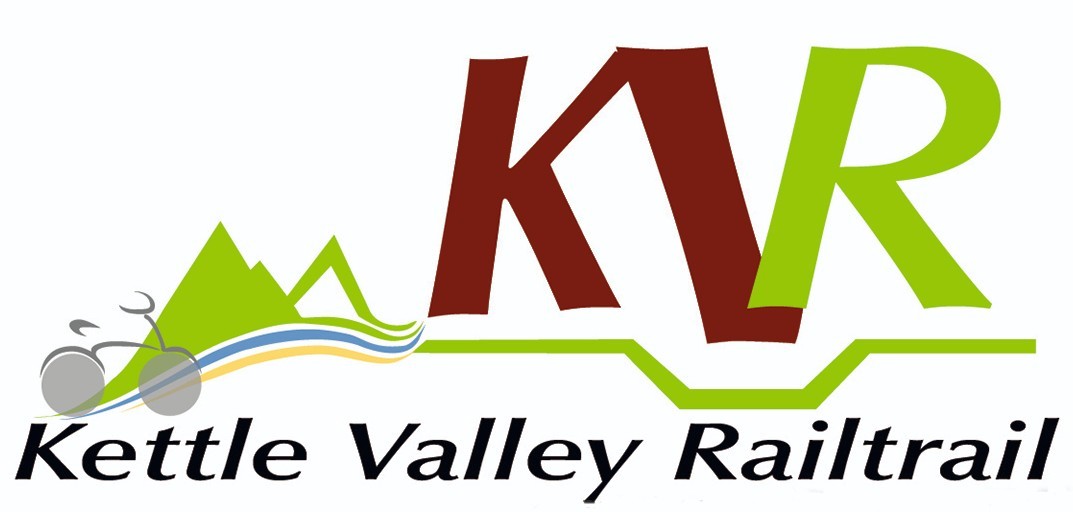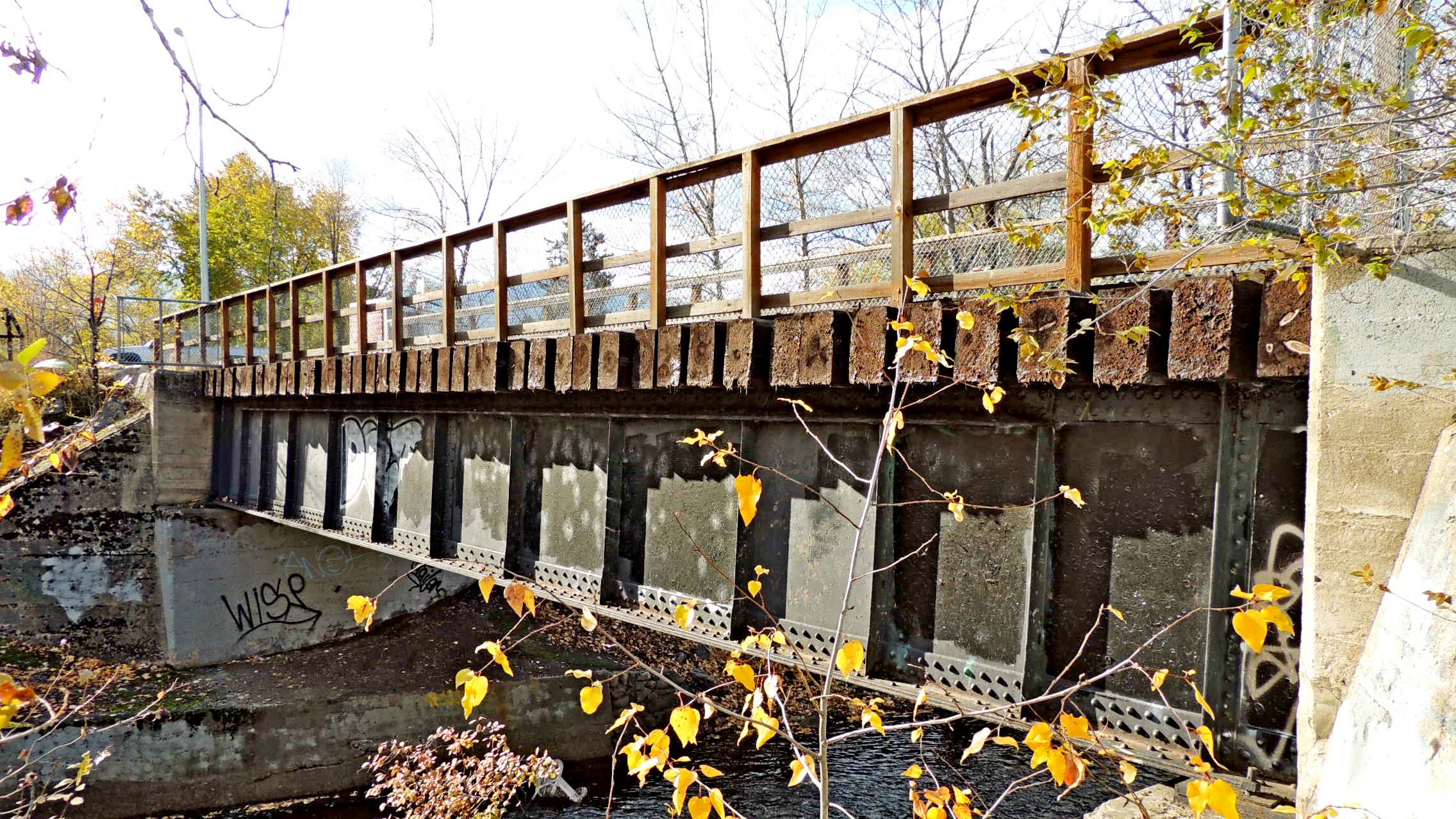|
 Penticton Creek Bridge - Penticton, BC Posted by:  T0SHEA T0SHEA
N 49° 29.739 W 119° 34.914
11U E 313044 N 5485761
This Kettle Valley Railway bridge was built in Penticton circa 1910 to carry the rails over Penticton Creek.
Waymark Code: WMQ64T
Location: British Columbia, Canada
Date Posted: 12/27/2015
Views: 3

Built in the early twentieth century, the Kettle Valley Railway (KVR), was a subsidiary of the CPR, the intention of which was to ensure a Canadian railroad presence in the Boundary Country and the South Okanagan. This Steel girder bridge was part of the first section of rail built by the KVR, known as the Carmi Subdivision, with construction beginning in 1910.
Declining use caused the elimination of passenger service on the KVR in 1964. Eight years later this, the Carmi Subdivision, was shut down, with the tracks being torn up sometime later. By 1989 the entire Kettle Valley Railway was abandoned and the tracks removed. In the 1990s work was begun on the construction of the Kettle Valley Rail Trail (KVRT), which encompasses essentially the entire KVR railbed, from Midway, BC to Hope.
Today the KVTR passes over this bridge, which is one of several access points for the trail in the City of Penticton. Major sections of the KVRT has since been incorporated into the Trans Canada Trail, including this section and this bridge.
From Rails to Trails
This pathway was originally the site of the Kettle Valley Railway which brought the first passenger train to Penticton in 1915. The KVR provided a vital transportation link for South Okanagan orchardists and ranchers. Evidently, it played a key role in the historical development of the Penticton area.
After 70 years of service, operation of the KVR was discontinued due to newer modes of transportation. The last train left Penticton in 1989.
In 1994, this section of railway between Vancouver Ave. and Calgary Ave. was upgraded and paved. Funding for the pathway project was provided by the Rotary Club of Penticton-Okanagan, the City of Penticton and many local, private and corporate citizens.
From the Rotary plaque at the bridge
![]()

A Brief History of the KVR
Canada welcomed British Columbia and its many resources into Confederation in 1871 with the promise of a railway that would extend from sea to sea. Fourteen years later the Canadian Pacific Railway (CPR) arrived in BC – a little later than planned – but here none the less. Unfortunately the CPR didn’t actually have track that serviced the people of Southern BC where mineral deposits like silver, were being discovered and a fruit industry was blossoming and would become world renown if only it could get to the coast!
In the 1890’s the CPR had extended their service to the South Okanagan constructing the Shuswap & Okanagan Railway from Sicamous on the CPR Mainline through to Okanagan Landing on Okanagan Lake. From that point CPR sternwheeler ships traveled south to Penticton carrying people and freight and making frequent stops along the way.
But this was a long trip to the coast or points east for people living in the South Okanagan and the demand came about for a “Coast-to-Kootenay” connection. Although rails were being laid by the CPR in other parts of BC, it was an American railroader, J.J. Hill who was making headway in the southern part of the province. He was trying to bring a rail line up from Spokane through Oroville and eventually this was accomplished with the acquisition the Vancouver, Victoria and Eastern Railway, a subsidiary of the Great Northern Railroad. It arrived in Keremeos in 1907, and in Hedley and Princeton two years later. The CPR, which was now under the leadership of Thomas Shaughnessy, had created the Columbia & Western Railway through the Crow’s Nest Pass to Midway. They had also put down track for the Nicola, Kamloops and Similkameen Railway.
In 1901 there had been a charter created for the Kettle River Valley Railway (KRVR) which was to connect a mine at Republic and a smelter at Grand Forks. It never materialized but an Ontario lawyer, J.J. Warren had taken over the financial problems of the almost defunct KRVR. He decided to have a chat with the CPR president Shaughnessy about the future of BC’s railways. He knew Sir Thomas “was a man deeply involved with the province and its future… and had personally founded a number of business enterprises in southern BC including the development of the Summerland Development Company which became largely responsible for making Okanagan fruit world famous” (Sanford, 1988).
Warren envisioned an alliance of the CPR and the KRVR which represented a subsidiary corporation and could be used to legally expand the rails west from Midway. And so the Kettle Valley Railway (KVR) was born and survey work began in 1910 from Midway to Penticton (Carmi division) and Penticton to Merritt (Princeton division). Shaughnessy felt that the line should also go through the Coquihalla Pass in order for the railway to be successful and work began on this subdivision a year later.
One of the many KVR engineering achievements designed by Andrew McCulloch was the Trout Creek Trestle Bridge in Summerland, which stretched 619 feet across and 238 feet above the Canyon floor. It was and is known as the “infinitesimal” bridge – “incalculable, inestimable, great and fathomless”. It was the highest structure of its kind on the KVR and the third largest of its kind in North America at the time it was built. The Trout Creek Bridge was upgraded in 1927 & 1928 by filling in the Trestle approaches and replacing trestle work with steel girders.
The earlier trains on the KVR were routed from Midway to Spence’s Bridge where they hooked up with the CPR mainline, but after July of 1916 the Coquihalla subdivision was complete and the trains traveled south from Brodie to Hope, meeting up with the CPR mainline there. In time the Coquihalla subdivision proved too much to handle suffering many washouts and snow and rock slides, so in 1959, after a series of abandonment, it was closed and the earlier route adopted once more. We must mention the increasing option of air travel so the KVR found its express service too expensive to maintain. In January, 1964 the final passenger run was made and eight years later the Carmi subdivision from Midway to Penticton was shut down and eventually the tracks were torn up.
While the KVR is said to have been built between 1910-1915 there were Branch lines added to the KVR mainline i.e.: at the end of World War One, a spur was constructed from Princeton to the mines at Copper Mountain; another eight-mile link line was added in 1930, from Penticton to Okanagan Falls. In order to increase fruit shipments to Great Britain during World War Two, this line was extended to Osoyoos. The CPR had officially taken over the KVR operations in 1930 and with the country in the throes of depression and the harsh decline in railway business; they decided to construct these rail lines in order to tap new sources of revenue.
Freight continued to run from Okanagan Falls to Spence’s Bridge until 1989. Much of the track was lifted within a few years except for a sixteen-kilometre stretch from the Trout Creek Bridge to Faulder.
From the KVR Society
Original Use: Railroad

Date Built: ca. 1910

Construction: Steel

Condition: Good

See this website for more information: [Web Link]

Date Abandoned: ca. 1972

Bridge Status - Orphaned or Adopted.: Adopted

|
Visit Instructions:
Tell of your visit and post unique photo(s).
Recent Visits/Logs:
| There are no logs for this waymark yet. |
|
|
|
|